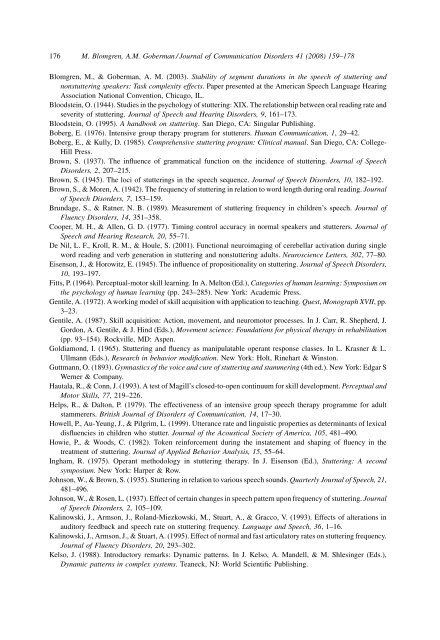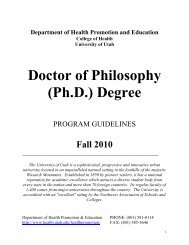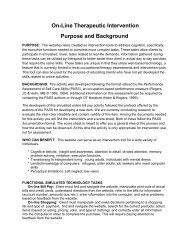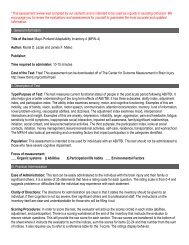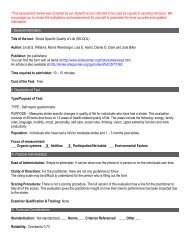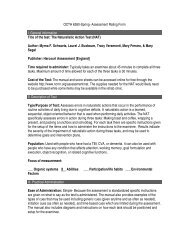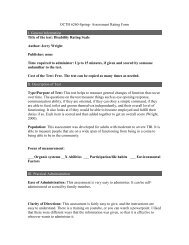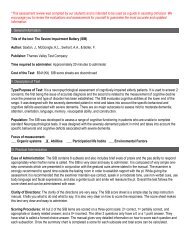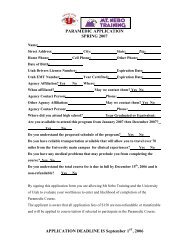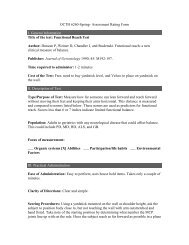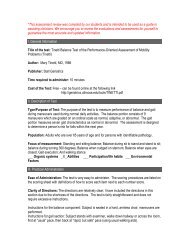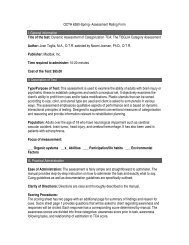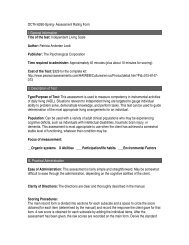Revisiting speech rate and utterance length ... - ResearchGate
Revisiting speech rate and utterance length ... - ResearchGate
Revisiting speech rate and utterance length ... - ResearchGate
You also want an ePaper? Increase the reach of your titles
YUMPU automatically turns print PDFs into web optimized ePapers that Google loves.
176M. Blomgren, A.M. Goberman / Journal of Communication Disorders 41 (2008) 159–178Blomgren, M., & Goberman, A. M. (2003). Stability of segment durations in the <strong>speech</strong> of stuttering <strong>and</strong>nonstuttering speakers: Task complexity effects. Paper presented at the American Speech Language HearingAssociation National Convention, Chicago, IL.Bloodstein, O. (1944). Studies in the psychology of stuttering: XIX. The relationship between oral reading <strong>rate</strong> <strong>and</strong>severity of stuttering. Journal of Speech <strong>and</strong> Hearing Disorders, 9, 161–173.Bloodstein, O. (1995). A h<strong>and</strong>book on stuttering. San Diego, CA: Singular Publishing.Boberg, E. (1976). Intensive group therapy program for stutterers. Human Communication, 1, 29–42.Boberg, E., & Kully, D. (1985). Comprehensive stuttering program: Clinical manual. San Diego, CA: College-Hill Press.Brown, S. (1937). The influence of grammatical function on the incidence of stuttering. Journal of SpeechDisorders, 2, 207–215.Brown, S. (1945). The loci of stutterings in the <strong>speech</strong> sequence. Journal of Speech Disorders, 10, 182–192.Brown, S., & Moren, A. (1942). The frequency of stuttering in relation to word <strong>length</strong> during oral reading. Journalof Speech Disorders, 7, 153–159.Brundage, S., & Ratner, N. B. (1989). Measurement of stuttering frequency in children’s <strong>speech</strong>. Journal ofFluency Disorders, 14, 351–358.Cooper, M. H., & Allen, G. D. (1977). Timing control accuracy in normal speakers <strong>and</strong> stutterers. Journal ofSpeech <strong>and</strong> Hearing Research, 20, 55–71.De Nil, L. F., Kroll, R. M., & Houle, S. (2001). Functional neuroimaging of cerebellar activation during singleword reading <strong>and</strong> verb generation in stuttering <strong>and</strong> nonstuttering adults. Neuroscience Letters, 302, 77–80.Eisenson, J., & Horowitz, E. (1945). The influence of propositionality on stuttering. Journal of Speech Disorders,10, 193–197.Fitts, P. (1964). Perceptual-motor skill learning. In A. Melton (Ed.), Categories of human learning: Symposium onthe psychology of human learning (pp. 243–285). New York: Academic Press.Gentile, A. (1972). Aworking model of skill acquisition with application to teaching. Quest, Monograph XVII, pp.3–23.Gentile, A. (1987). Skill acquisition: Action, movement, <strong>and</strong> neuromotor processes. In J. Carr, R. Shepherd, J.Gordon, A. Gentile, & J. Hind (Eds.), Movement science: Foundations for physical therapy in rehabilitation(pp. 93–154). Rockville, MD: Aspen.Goldiamond, I. (1965). Stuttering <strong>and</strong> fluency as manipulatable operant response classes. In L. Krasner & L.Ullmann (Eds.), Research in behavior modification. New York: Holt, Rinehart & Winston.Guttmann, O. (1893). Gymnastics of the voice <strong>and</strong> cure of stuttering <strong>and</strong> stammering (4th ed.). New York: Edgar SWerner & Company.Hautala, R., & Conn, J. (1993). A test of Magill’s closed-to-open continuum for skill development. Perceptual <strong>and</strong>Motor Skills, 77, 219–226.Helps, R., & Dalton, P. (1979). The effectiveness of an intensive group <strong>speech</strong> therapy programme for adultstammerers. British Journal of Disorders of Communication, 14, 17–30.Howell, P., Au-Yeung, J., & Pilgrim, L. (1999). Utterance <strong>rate</strong> <strong>and</strong> linguistic properties as determinants of lexicaldisfluencies in children who stutter. Journal of the Acoustical Society of America, 105, 481–490.Howie, P., & Woods, C. (1982). Token reinforcement during the instatement <strong>and</strong> shaping of fluency in thetreatment of stuttering. Journal of Applied Behavior Analysis, 15, 55–64.Ingham, R. (1975). Operant methodology in stuttering therapy. In J. Eisenson (Ed.), Stuttering: A secondsymposium. New York: Harper & Row.Johnson, W., & Brown, S. (1935). Stuttering in relation to various <strong>speech</strong> sounds. Quarterly Journal of Speech, 21,481–496.Johnson, W., & Rosen, L. (1937). Effect of certain changes in <strong>speech</strong> pattern upon frequency of stuttering. Journalof Speech Disorders, 2, 105–109.Kalinowski, J., Armson, J., Rol<strong>and</strong>-Miezkowski, M., Stuart, A., & Gracco, V. (1993). Effects of alterations inauditory feedback <strong>and</strong> <strong>speech</strong> <strong>rate</strong> on stuttering frequency. Language <strong>and</strong> Speech, 36, 1–16.Kalinowski, J., Armson, J., & Stuart, A. (1995). Effect of normal <strong>and</strong> fast articulatory <strong>rate</strong>s on stuttering frequency.Journal of Fluency Disorders, 20, 293–302.Kelso, J. (1988). Introductory remarks: Dynamic patterns. In J. Kelso, A. M<strong>and</strong>ell, & M. Shlesinger (Eds.),Dynamic patterns in complex systems. Teaneck, NJ: World Scientific Publishing.


